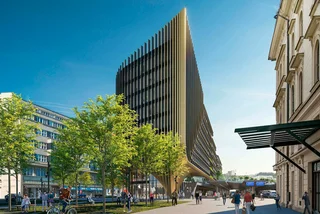For Czech fans of Apple’s iPhone, it is bad news almost all around. The new iPhone 13 was launched at the end of September but sold out instantly, and people who hesitated will now wait several weeks for delivery of the most popular configurations due to high demand and a shortage of chips.
Those making a Czech salary also have to work longer than many other people in Europe to be able to afford the new model, though, in one bright spot, it is a few days less than for the previous model when it was new.
The arrival of a full-size Apple Store in the Czech Republic, something that Prime Minister Andrej Babiš promised in 2019, now seems years away at the earliest, and it is not a priority for either the likely new Czech government or Apple.
And the European Union again has its regulatory eyes focused on the computer and accessory giant, seeking to force them to make their devices notoriously incompatible devices use standard USB-C chargers. Though, with the speed at which the EU works, charging cables might be a thing of the past by the time the rule goes into effect.
Order Pro models now for the holidays
The new iPhone 13 came to the Czech market on Sept. 24, and the first ones were gone within hours. Currently, there are no new models on shelves, and people who want one will have to order them and wait several weeks. The wait time is expected to grow even longer as the holiday season gets closer.
Apple had planned to produce 90 million iPhone 13 units by the end of this year, but recently announced they will miss that target by as many a 10 million units since its chip suppliers, including Broadcom and Texas Instruments, are having difficulty meeting their quotas. At the same time, demand for the new phone is double compared to previous new models.
“There has been significantly more interest in the new iPhone lineup this year than in past years. We have 105 percent more orders for the iPhone 13 compared to the iPhone 12 in the first four weeks since the product announcements. Interest is higher year on year, and this year we attribute this mainly to the lower than expected price of the new models. Delivery times are currently several weeks,” Miroslav Winter, Apple product manager at iWant, told the Czech News Agency (ČTK).
Daniela Chovancová, spokeswoman for electronics chain Alza, said the waiting time for the basic iPhone 13 and iPhone 13 mini is just a matter of days. “In the coming weeks, we already expect a gradual build-up of stock for these models, ” she told ČTK.
“For the Pro and Pro Max models, where we are seeing higher demand, the waiting time for new orders that are now being closed is about a month. We process all orders in order of their closing date. Those who would like to get a new model under the Christmas tree are advised to order as soon as possible, ” she said.
Work three weeks to afford an iPhone 13 Pro
Every year, discount server Picodi.com releases what it calls the iPhone index, showing how long someone has to work to afford the current model.
The most recent ranking shows that, based on an average Czech salary and locally advertised prices, someone has to work 21.4 days to buy an iPhone 13 Pro with 128 GB. The shortest time was in Switzerland, at 4.4 days, while the longest was in Turkey, at 92.5 days.
European counties where people worked fewer days than in the Czech Republic to get the new iPhone included Switzerland, Luxembourg, Denmark, Norway, Ireland, Germany, Finland, the Netherlands, France, Austria, Britain, Belgium, Sweden, Cyprus, Spain, Italy, Malta, Slovenia, and Estonia.
On the other hand, people in some European countries work longer. These include Portugal, Lithuania, Greece, Poland, Latvia, Slovakia, Hungary, Russia, Montenegro, and Turkey.
The relatively good news is the amount of time to buy the latest Apple phone is dropping in the Czech Republic. It had been 26.2 days in 2018, but it fell to 25.2 in 2019 and 24.5 in 2020.
Don’t count your Apple Stores before they hatch
As for an official Apple Store coming to Prague, the latest information comes from early May. Someone spotted a small detail that had gone unnoticed on architectural images for the flagship building for Penta’s Masaryčka development next to Masarykovo nádraží. Over the main entrance, there is a small but distinct Apple brand logo. The building, designed by Zaha Hadid, is currently under construction and should open in 2025.
BlÞà se pÅ™Ãchod oficiálnà prodejny Apple do ÄŒeska? Penta zveÅ™ejnila nové vizualizace námÄ›stà u Masarykova nádražà a jedna z prodejen nese právÄ› logo Apple. pic.twitter.com/LCJAsEKzXE
— Martin Å tÄ›rba (@sterbamartin) May 5, 2021
“For now, take it as a purely theoretical possibility,” Penta Real Estate spokesman Ivo Mravinac said.
“In the same way, there may be a premium reseller for Apple. I do not want to say that we are not negotiating [with Apple], but it is too early for a clear answer – whether positive or negative. There is considerable interest in commercial space in Zaha Hadid's buildings, but in the case of Apple, the current situation is such that I can only write: This potential tenant would simply please us,” he told tech server LsA magazine at the time.
This wasn’t the first rumor of a big Apple Store coming to Prague. Press speculated in August 2020 that an Apple Store was coming, based on a Tweet from Prime Minister Andrej Babiš, but it turned out to be a false alarm.
Apple shánà zamÄ›stnance pro pražský Store ðŸ‘https://t.co/ZkjoHOflQF
— Andrej BabiÅ¡ (@AndrejBabis) August 25, 2020
There was also a brief rumor that an Apple Store would open in the new Flow Building on Wenceslas Square, but the retail space in the mixed-use building is exclusively used by fashion retailer Primark, with no room for anyone else.
Babiš in January 2019 promised to bring an Apple Store to the Czech Republic, after meeting with Apple CEO Tim Cook. Apple, though, has slowed down on launching new stores due to the pandemic.
The Czech Republic does have two Apple Shops, Apple-authorized and implemented physical locations inside of third-party retailers. One of these is inside the Alza showroom in Prague 7–Holešovice, and a second one opened in December 2020 in Plzeň, West Bohemia.
Make your own USB-C compatible phone
At the end of September, the European Commission issued an 18-page directive calling for a common charger for all smartphones, tablets, cameras, headphones, portable speakers, and handheld videogame consoles. The directive calls for USB-C cables, now used for many Android devices, to become universal in the European Union, including the Czech Republic. Apple now uses what it calls a Lightning cable for its phones.
The switch to one cable would save consumers money and also reduce electronic waste, which has been a problem for decades. Chargers would also be sold separately, so people wouldn’t wind up gathering unneeded chargers every time they bought a new device.
The proposal still has to be adopted by the EU member states, after which there will be a two-year transition period.
Apple, whose products are notoriously not compatible with other brands, has objected to the proposal. “We remain concerned that strict regulation mandating just one type of connector stifles innovation rather than encouraging it, which in turn will harm consumers in Europe and around the world,” Apple said in a statement in September.
While the EU is in the midst of trying to force computer giant Apple to use the same recharging cables are virtually everyone else, Ken Pillonel, a robotics student at the Swiss Federal Institute of Technology, has taken matters into his own hands and made the conversion himself.
It was more complex than just soldering in a new jack. Pillonel showed his results in a short video and promises a more detailed look soon.
“This is it, people, the world’s first USB-C iPhone. Now I know it doesn’t look very special, but watch this,” he said, showing that the iPhone lit up when it was plugged into the cable. “And data is also supported,” he added.
It was Pillonel’s third video in the series, after two that outlined the technical problems and possible solutions for conversion. But from the looks of it, it isn’t the sort of simple fix that anyone, even someone with technical savvy, can easily do. But it at least offers hope for people who want to get rid of the tangle of converters and cables that inevitably fill a desk drawer.
Apple though may just stay ahead of the game. In 2020 the company announced a wireless recharger called MagSafe, which doesn’t rely on jacks at all, but instead connects to the phone via a magnet. Apple was the first to drop earphone jacks when cable-free headphones were introduced. Some industry insiders already speculate that the recharging jack will be the next to go.












 Reading time: 6 minutes
Reading time: 6 minutes 






























